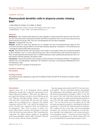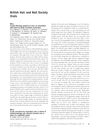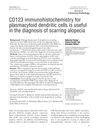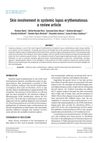Reply to ‘CD123 Immunohistochemistry for Plasmacytoid Dendritic Cells Is Useful in the Diagnosis of Scarring Alopecia’: Three PDC-Related Parameters Are Useful in Differentiating Lupus Alopecia from LPP
November 2016
in “
Journal of Cutaneous Pathology
”
plasmacytoid dendritic cells PDCs scarring alopecia lupus alopecia lichen planopilaris LPP frontal fibrosing alopecia FFA CD123 immunostaining chronic cutaneous lupus erythematosus CCLE central centrifugal cicatricial alopecia CCCA BDCA-2 immunohistochemical staining dermoepidermal junction DEJ myxovirus protein A MxA immunostaining LE-associated alopecia CD123 BDCA-2 MxA
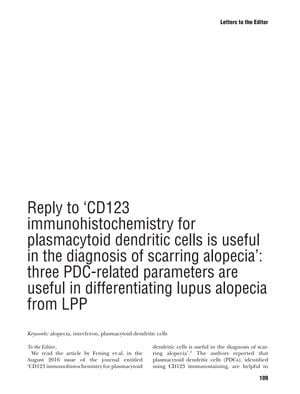
TLDR Three characteristics of plasmacytoid dendritic cells help tell apart lupus-related hair loss from LPP.
In a letter to the editor, the authors discussed the utility of plasmacytoid dendritic cells (PDCs) in diagnosing scarring alopecia, specifically differentiating lupus alopecia from lichen planopilaris (LPP) and its variant frontal fibrosing alopecia (FFA). They referenced a study by Fening et al. that evaluated 45 biopsies and found that PDCs, identified by CD123 immunostaining, were more prevalent and clustered in chronic cutaneous lupus erythematosus (CCLE) cases compared to LPP and central centrifugal cicatricial alopecia (CCCA). The authors of the letter confirmed these findings in their own study of 47 cases (17 LE-associated alopecia, 20 LPP, and 10 FFA) using BDCA-2 immunohistochemical staining for PDCs. They found that LE-associated alopecia had significantly higher PDC content, clustering, and deeper dermal and perieccrine distribution, with involvement of the dermoepidermal junction (DEJ), while LPP and FFA had less PDC content, rare clustering, and rare DEJ involvement. Additionally, they evaluated PDC activity through myxovirus protein A (MxA) immunostaining and found that while all cases showed positive MxA staining, the intensity was different, with all LE cases showing intense diffuse staining compared to only 25% of LPP and 10% of FFA cases. These findings suggest that PDC content, clustering, distribution, and MxA staining intensity can be useful parameters in differentiating LE-associated alopecia from LPP/FFA.
